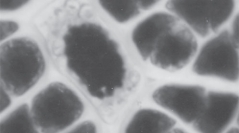

 Cryptogamie, Algologie
26 (2) - Pages 177-188
Cryptogamie, Algologie
26 (2) - Pages 177-188Seventeen samples and specimens of Prasiola from central Mexico, representing two species, have been studied in laboratory culture. The most common species, P. mexicana, is characterized by large leaf-like thalli (≥ 90 mm), bifurcating branches and a smooth margin. The lamina apex has numerous aplanospores and the margin is polystromatic (≥ 8 layers). Specimens with a corrugated surface and rhizoidal cells in the middle region were also noted. The second species, P. nevadensis, is characterized by small, leaf-like thalli (≥ 30 mm), crenate margins, and a monostromatic lamina. Two relevant morphological features were noted in culture: multilocular gametangia with possible female gametes, and the formation of small cellular packets fixed to the apical margin of the lamina. Prasiola nevadensis is here reported for the first time for Mexico, which also represents only the second report for the species. Prasiola mexicana was found in subaerial or submerged conditions in cold rivers (2-16.4ºC), neutral pH (6.4-7.6) and low specific conductivity (35.5-94.2 μS.cm–1). Prasiola nevadensis was collected submerged in a river with cold water (14ºC), acidic pH (5.5), and moderate specific conductivity (192 μS·cm–1). Both species were collected in high mountain regions (≥ 1300 masl).